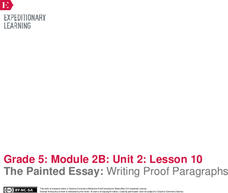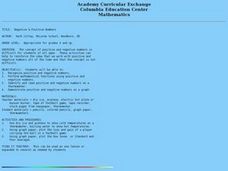Curated OER
Solar Kit Lesson #6: Solar-Powered Battery Charger
In a previous instructional activity, learners build an ammeter. That ammeter, or a pre-made one, is required in order to carry out this instructional activity. The objective is for lab groups to design a way to connect solar cells that...
Curated OER
Log Cabin in a Thunderstorm Lesson Plan
Students work on a K-W-L chart about electrical storms, lightening, and thunder. They discuss how meteorologists forecast storms and research their answers which are shared in a whole class setting. Using art supplies, they draw dwelling...
Curated OER
All Things Science Jeopardy
"Jeopardy"-style PowerPoints are a favorite for students! This resource covers four categories, and has a ????? category as well. The categories are: animal adaptations, sound, electricity, and Earth. The hints are high-level, and this...
Teach Engineering
Statistical Analysis of Flexible Circuits
Scholars connect statistical analysis with flexible electric circuits. They first learn about flexible circuits and their applications through a PowerPoint presentation and then consider how the fabrication process for these circuits...
University of Minnesota
Virtual Neurons
It's electric! Young anatomists use Virtual Neurons software to build, control, and analyze complex nerve circuits within the body. Colorful and packed with content, class members enjoy interacting with the nervous system at a personal...
University of Minnesota
Mindflex Activity
Control a ball with your mind! Using a headset with an electrode, learners adjust the movement of a ball. They develop an experiment that tests the involvement of the central nervous system in controlling the ball. The activity helps to...
DiscoverE
Wind Farm
A wind turbine is essentially just a giant pinwheel, right? Individuals first create pinwheels from paper, pins, and pencils. In groups, they model a wind farm along a coast and then test out their designs using an electric fan.
Science Matters
May the Magnetic Force Be with You
Attraction and repulsive forces might seem mysterious to young learners. Have your classes experiment with these forces in the second installment of a 14-part unit on magnetism and electricity. Individuals test different objects in the...
Science Matters
Magnetic Fields: The Earth Acts as a Giant Magnet
Attract learners to an interesting lesson! The third in a 14-part series of lessons on electricity and magnetism uses a hands-on approach to exploring magnetic fields. Scholars experiment with a compass to test Earth's magnetic field and...
Constitutional Rights Foundation
Winner-Take-All: The Two-Party System
Two's company, three's a crowd. High school historians learn about the Electoral College, a two-party, winner-take-all voting system in the United States. The instructional activity explains the pros and cons of the two-party system,...
Bonneville
Photovoltaic Solutions "Shark-Tank Style"
Come up with a great idea and change the world for the better. Working in groups of three, learners apply their knowledge of photovoltaic systems to design a battery-powered electric vehicle capable of replacing gas-powered cars. They...
EngageNY
The Painted Essay: Writing Proof Paragraphs
Words of proof. Learners continue coding The Electric Motor by marking the first point in yellow and the second point in blue. They discuss the structure of the paragraphs by identifying transition words and evidence to support the given...
EngageNY
The Painted Essay: Developing a Conclusion and Adding Linking Words
In conclusion ... this essay is the best! Scholars continue working on their painted essays by creating the conclusion. They work in groups to analyze the concluding paragraph in the model painted essay, The Electric Motor. After...
EngageNY
The Painted Essay: The Introductory Paragraph
Mimic the model for the perfect essay. Scholars work in groups to analyze a model painted essay The Electric Motor. They compare the structure of the model essay to the painted essay template they created in the previous activity. The...
Institute of Electrical and Electronics Engineers
Working with Watermills
In collaborative groups, emerging engineers or environmental scientists plan and construct a water wheel or watermill that rotates for a total of three minutes. Everything you need to carry out this lesson is included: objectives,...
Curated OER
Allocating Energy from a Photovoltaic System
How much electricity do you use in a day? Physics fanatics calculate their energy use by consulting a chart of the watts required to run typical household appliances. They compare power to amounts of electric energy used or generated....
Curated OER
Permit Trading
Emerging environmentalists work in groups and pretend that each is a power company generating electricity for a community. They consider the costs of building a renewable electricity generator that will increasingly replace generating...
Curated OER
The Strongest Pump of All
Students examine how the heart functions and the concept of how electrical currents can affect muscle contractions. In this cardiovascular lesson students identify P, QRS and T complexes.
Carnegie Mellon University
How Power Plants Work 1
First of three lessons, this is a great start to a unit on energy. As you demonstrate, learners discover different types of energy and how it is converted from one form to another. They then focus in on the generation of electricity by...
Curated OER
Energy and Energy Conversion
Third graders investigate different energy conversions through hands-on activities. In this energy lesson, 3rd graders move through four stations and conduct experiments illustrating energy conversions. Wave energy, chemical energy,...
Curated OER
Negative and Positive Numbers
Help scholars explain the concept of positive and negative numbers. Here you will find three separate activities that will help them to correlate positive and negative numbers with real life. Note: Activities require that the teacher...
Curated OER
Too Bright At Night?
Students explain what causes light pollution and how it can be curtailed. They consider the negative consequences of nighttime lighting, enabled by the invention of electric lights at the close of the 19th Century.
Curated OER
When Things Start Heating Up
Fourth graders discover how heat is produced from human-based activities and mechanical and electrical machines. They discover characteristics of things that give off heat and those that don't. Students create a chart to record...
Curated OER
Electronic Components
Students describe how resistors affect the flow of electricity. In this electronics lesson students examine transistors and what they do and how they work.
Other popular searches
- Static Electricity
- Electricity and Magnetism
- Electricity Experiments
- Current Electricity
- Basic Electricity
- Science Static Electricity
- Science Electricity
- Basic Electricity Worksheets
- Electricity and Light Bulb
- Electricity Circuits
- Electricity Magnet
- Electricity Lesson Plans

























